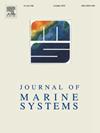南大洋海洋热浪的时空格局及其在海气相互作用中的作用
IF 2.5
3区 地球科学
Q2 GEOSCIENCES, MULTIDISCIPLINARY
引用次数: 0
摘要
海洋热浪(MHWs)是指温度超过90个百分位阈值限制的长时间异常温暖的海洋条件。虽然先前的研究主要集中在区域趋势上,但尽管近几十年来经历了相当大的变暖,但对南大洋,特别是南极洲周围的南大洋的研究相对不足。本研究调查了1982年至2022年南大洋的强震,突出了其频率、强度和天数的显著时空变化。在65°S以北,特别是夏季,强热带副热带气旋更为频繁(每10年0.4次),发生频率在2008年后显著上升,与人为气候变化和海表温度升高相一致。该研究还确定了厄尔尼诺Niño和印度洋偶极子(IOD)等气候模式对强震强度和频率的影响,特别是在春季和秋季的罗斯海。我们分析了2013年显著强震对大气的影响。2013年MHW事件是极端地下变暖的一个重要例子,在120米深处温度达到6.2°C,显著增加了该地区的热含量。这突出了MHWs如何垂直传播热量,影响海洋表层和深海层。这些发现强调了海洋动力学和大气条件之间复杂的相互作用在决定南大洋的mhw模式,为预测该地区未来对气候变化的反应提供了重要的见解。本文章由计算机程序翻译,如有差异,请以英文原文为准。
Spatiotemporal patterns of marine heatwaves in the Southern Ocean and their role in air-sea interaction
Marine heatwaves (MHWs) are extended periods of abnormally warm ocean conditions in which temperature exceeds the 90th percentile threshold limit. While prior studies have mainly focused on regional trends, the Southern Ocean, particularly around Antarctica, has been relatively understudied despite experiencing considerable warming in recent decades. This study investigates MHWs in the Southern Ocean from 1982 to 2022, highlighting significant spatial and temporal variations in their frequency, intensity, and days. MHWs were found to be more frequent (0.4 events per decade) and intense north of 65°S, especially during the summer, with a marked rise in occurrence after 2008, coinciding with anthropogenic climate change and increasing sea surface temperatures (SST). The study also identifies the influence of climate patterns such as El Niño and the Indian Ocean Dipole (IOD) on MHWs intensity and frequency, particularly in the Ross Sea during spring and autumn. We analyzed the atmospheric impacts of significant MHWs in 2013. The 2013 MHW event serves as a key example of extreme subsurface warming, where temperatures reached 6.2 °C at 120 m depth, significantly increasing the region's heat content. This highlights how MHWs can transmit heat vertically, impacting both surface and deep ocean layers. The findings emphasize the complex interactions between ocean dynamics, and atmospheric conditions in determining MHWs patterns in the Southern Ocean, offering crucial insights for predicting the region's future responses to climate change.
求助全文
通过发布文献求助,成功后即可免费获取论文全文。
去求助
来源期刊

Journal of Marine Systems
地学-地球科学综合
CiteScore
6.20
自引率
3.60%
发文量
81
审稿时长
6 months
期刊介绍:
The Journal of Marine Systems provides a medium for interdisciplinary exchange between physical, chemical and biological oceanographers and marine geologists. The journal welcomes original research papers and review articles. Preference will be given to interdisciplinary approaches to marine systems.
 求助内容:
求助内容: 应助结果提醒方式:
应助结果提醒方式:


